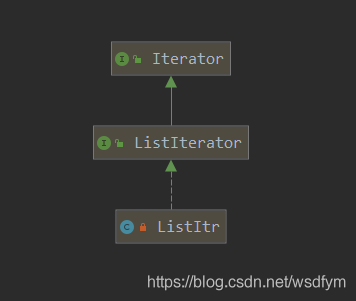您好,登錄后才能下訂單哦!
您好,登錄后才能下訂單哦!
這篇文章主要介紹“Java List的remove()方法陷阱以及性能優化的方法教程”,在日常操作中,相信很多人在Java List的remove()方法陷阱以及性能優化的方法教程問題上存在疑惑,小編查閱了各式資料,整理出簡單好用的操作方法,希望對大家解答”Java List的remove()方法陷阱以及性能優化的方法教程”的疑惑有所幫助!接下來,請跟著小編一起來學習吧!
Java List在進行remove()方法是通常容易踩坑,主要有一下幾點
循環時:問題在于,刪除某個元素后,因為刪除元素后,后面的元素都往前移動了一位,而你的索引+1,所以實際訪問的元素相對于刪除的元素中間間隔了一位。
//錯誤的方法
for(int i=0;i<list.size();i++) {
if(list.get(i)%2==0) {
list.remove(i);
}
}for(Integer i:list) {
if(i%2==0) {
list.remove(i);
}
}拋出異常:java.util.ConcurrentModificationException;
foreach的本質是使用迭代器實現,每次進入for (Integer i:list) 時,會調用ListItr.next()方法;
繼而調用checkForComodification()方法, checkForComodification()方法對操作集合的次數進行了判斷,如果當前對集合的操作次數與生成迭代器時不同,拋出異常
public E next() {
checkForComodification();
if (!hasNext()) {
throw new NoSuchElementException();
}
lastReturned = next;
next = next.next;
nextIndex++;
return lastReturned.item;
}
// checkForComodification()方法對集合遍歷前被修改的次數與現在被修改的次數做出對比
final void checkForComodification() {
if (modCount != expectedModCount) {
throw new ConcurrentModificationException();
}
}使用for循環,并且同時改變索引;(正確)
//正確
for(int i=0;i<list.size();i++) {
if(list.get(i)%2==0) {
list.remove(i);
i--;//在元素被移除掉后,進行索引后移
}
}使用for循環,倒序進行;(正確)
//正確
for(int i=list.size()-1;i>=0;i--) {
if(list.get(i)%2==0) {
list.remove(i);
}
}使用while循環,刪除了元素,索引便不+1,在沒刪除元素時索引+1(正確)
//正確
int i=0;
while(i<list.size()) {
if(list.get(i)%2==0) {
list.remove(i);
}else {
i++;
}
}只能使用迭代器的remove()方法,使用列表的remove()方法是錯誤的
//正確,并且推薦的方法
Iterator<Integer> itr = list.iterator();
while(itr.hasNext()) {
if(itr.next()%2 ==0)
itr.remove();
}下面來談談當數據量過大時候,需要刪除的元素較多時,如何用迭代器進行性能的優化,對于ArrayList這幾乎是致命的,從一個ArrayList中刪除批量元素都是昂貴的時間復雜度為O(n²),那么接下來看看LinkeedList是否可行。LinkedList暴露了兩個問題,一個:是每次的Get請求效率不高,而且,對于remove的調用同樣低效,因為達到位置I的代價是昂貴的。
是每次的Get請求效率不高
需要先get元素,然后過濾元素。比較元素是否滿足刪除條件。
remove的調用同樣低效
LinkedList的remove(index),方法是需要先遍歷鏈表,先找到該index下的節點,再處理節點的前驅后繼。
以上兩個問題當遇到批量級別需要處理時時間復雜度直接上升到O(n²)
對于LinkedList,對該迭代器的remove()方法的調用只花費常數時間,因為在循環時該迭代器位于需要被刪除的節點,因此是常數操作。對于一個ArrayList,即使該迭代器位于需要被刪除的節點,其remove()方法依然是昂貴的,因為數組項必須移動。下面貼出示例代碼以及運行結果

public class RemoveByIterator {
public static void main(String[] args) {
List<Integer> arrList1 = new ArrayList<>();
for(int i=0;i<100000;i++) {
arrList1.add(i);
}
List<Integer> linList1 = new LinkedList<>();
for(int i=0;i<100000;i++) {
linList1.add(i);
}
List<Integer> arrList2 = new ArrayList<>();
for(int i=0;i<100000;i++) {
arrList2.add(i);
}
List<Integer> linList2 = new LinkedList<>();
for(int i=0;i<100000;i++) {
linList2.add(i);
}
removeEvens(arrList1,"ArrayList");
removeEvens(linList1,"LinkedList");
removeEvensByIterator(arrList2,"ArrayList");
removeEvensByIterator(linList2,"LinkedList");
}
public static void removeEvensByIterator(List<Integer> lst ,String name) {//利用迭代器remove偶數
long sTime = new Date().getTime();
Iterator<Integer> itr = lst.iterator();
while(itr.hasNext()) {
if(itr.next()%2 ==0)
itr.remove();
}
System.out.println(name+"使用迭代器時間:"+(new Date().getTime()-sTime)+"毫秒");
}
public static void removeEvens(List<Integer> list , String name) {//不使用迭代器remove偶數
long sTime = new Date().getTime();
int i=0;
while(i<list.size()) {
if(list.get(i)%2==0) {
list.remove(i);
}else {
i++;
}
}
System.out.println(name+"不使用迭代器的時間"+(new Date().getTime()-sTime)+"毫秒");
}
}原理 重點看一下LinkedList的迭代器
另一篇博客Iterator簡介 LinkedList使用迭代器優化移除批量元素原理
調用方法:list.iterator();

重點看下remove方法
private class ListItr implements ListIterator<E> {
//返回的節點
private Node<E> lastReturned;
//下一個節點
private Node<E> next;
//下一個節點索引
private int nextIndex;
//修改次數
private int expectedModCount = modCount;
ListItr(int index) {
//根據傳進來的數字設置next等屬性,默認傳0
next = (index == size) ? null : node(index);
nextIndex = index;
}
//直接調用節點的后繼指針
public E next() {
checkForComodification();
if (!hasNext())
throw new NoSuchElementException();
lastReturned = next;
next = next.next;
nextIndex++;
return lastReturned.item;
}
//返回節點的前驅
public E previous() {
checkForComodification();
if (!hasPrevious())
throw new NoSuchElementException();
lastReturned = next = (next == null) ? last : next.prev;
nextIndex--;
return lastReturned.item;
}
/**
* 最重要的方法,在LinkedList中按一定規則移除大量元素時用這個方法
* 為什么會比list.remove效率高呢;
*/
public void remove() {
checkForComodification();
if (lastReturned == null)
throw new IllegalStateException();
Node<E> lastNext = lastReturned.next;
unlink(lastReturned);
if (next == lastReturned)
next = lastNext;
else
nextIndex--;
lastReturned = null;
expectedModCount++;
}
public void set(E e) {
if (lastReturned == null)
throw new IllegalStateException();
checkForComodification();
lastReturned.item = e;
}
public void add(E e) {
checkForComodification();
lastReturned = null;
if (next == null)
linkLast(e);
else
linkBefore(e, next);
nextIndex++;
expectedModCount++;
}
}LinkedList 源碼的remove(int index)的過程是
先逐一移動指針,再找到要移除的Node,最后再修改這個Node前驅后繼等移除Node。如果有批量元素要按規則移除的話這么做時間復雜度O(n²)。但是使用迭代器是O(n)。
LinkedList是雙向鏈表,這里示意圖簡單畫個單鏈表
比如要移除鏈表中偶數元素,先循環調用get方法,指針逐漸后移獲得元素,比如獲得index = 1;指針后移兩次才能獲得元素。
當發現元素值為偶數是。使用idnex移除元素,如list.remove(1);鏈表先Node node(int index)返回該index下的元素,與get方法一樣。然后再做前驅后繼的修改。所以在remove之前相當于做了兩次get請求。導致時間復雜度是O(n)。


繼續移除下一個元素需要重新再走一遍鏈表(步驟忽略當index大于半數,鏈表倒序查找)

以上如果移除偶數指針做了6次移動。
刪除2節點
get請求移動1次,remove(1)移動1次。
刪除4節點
get請求移動2次,remove(2)移動2次。
迭代器的next指針執行一次一直向后移動的操作。一共只需要移動4次。當元素越多時這個差距會越明顯。整體上移除批量元素是O(n),而使用list.remove(index)移除批量元素是O(n²)

到此,關于“Java List的remove()方法陷阱以及性能優化的方法教程”的學習就結束了,希望能夠解決大家的疑惑。理論與實踐的搭配能更好的幫助大家學習,快去試試吧!若想繼續學習更多相關知識,請繼續關注億速云網站,小編會繼續努力為大家帶來更多實用的文章!
免責聲明:本站發布的內容(圖片、視頻和文字)以原創、轉載和分享為主,文章觀點不代表本網站立場,如果涉及侵權請聯系站長郵箱:is@yisu.com進行舉報,并提供相關證據,一經查實,將立刻刪除涉嫌侵權內容。